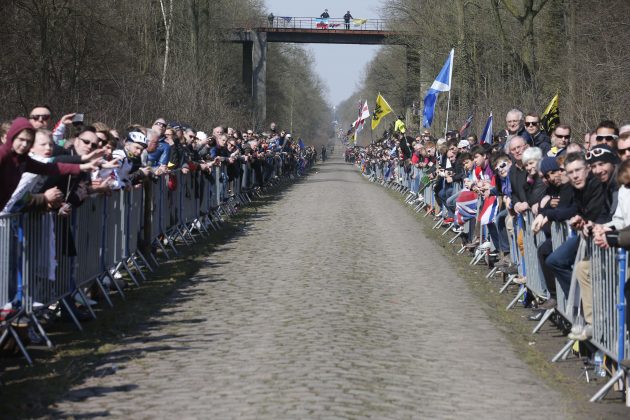From narrowing the approach to no Arenberg at all: Six ways to solve Paris-Roubaix's trench problem
The Hell of the North will take a slightly different approach to the Arenberg pavé this year. Here are our alternatives


It probably hasn't escaped your attention that the run-in to the notorious stretch of cobbles at Arenberg in this year's Paris-Roubaix is going to be different.
Having listened to the concerns of riders, race organiser ASO – which also heads up the Tour de France as well as numerous other prestigious events including Paris-Nice and the Critérium du Dauphiné – has inserted a fairly major chicane immediately ahead of the entrance to the pavé.
The hope is that it will mitigate for the sudden narrowing of the course as it enters what is the most foreboding stretch of cobbles in the race – not least because it is unique in running through a dark forest, and usually done at speed.
But the chicane – which in reality is more akin to a minor and very technical detour – hasn't gone down well with everyone, race favourite Mathieu van der Poel included, who asked "is this a joke"?
In a traditional sport like cycling, in which individual stretches of road and the feats of derring-do occasioned upon them are held in such high regard, there is no easy solution to a problem like the Arenberg. There are a few options though – try these for size.
1. Narrow the course well in advance
The problem with the Arenberg is two-fold. The first component being that the cobbles are slippery, ragged and uneven, and horrible to crash on. As riders have reportedly told the CPA, the riders' union, and ASO, the race organisers, they would rather face a potentially increased risk of crash on tarmac than face the same fate on the cobbles.
The second component is that the road narrows as it enters the cobbles. It's not a gradual narrowing either – it all happens within less than 50 metres. The two factors combined equals often predictably chaotic results.
The latest race content, interviews, features, reviews and expert buying guides, direct to your inbox!
This option would see the course narrowed down slowly well in advance of the cobbles, with safety bales where necessary, meaning no further narrowing as the riders reach the pavé itself.
Pros
Straightforward to implement, the traditional route can be used
Cons
Narrowing still exists
2. Use a safety car

Cycling borrows carbon-fibre and aerodynamics technology from motor racing as a matter of course, so why not look to our motorised brethren to help sort the Arenberg problem?
In this scenario, the race would be slowed on the approach to the entrance to the cobbles using a motorsport-style safety car. It would drive ahead of the pack at a speed of, say 20mph / 30kph until the peloton is safely on the pavé.
At this point it either speeds up or pulls off the course, leaving all hell to let loose in the pack. It could be quite the spectacle.
Pros
It could make the Arenberg even more exciting than it already is; the same, traditional course can still be used
Cons
Ensuring fairness could be complex if the race is split into different groups; the entire pack would be attacking together on the cobbles, which could be dangerous
3. The 2024 chicane
For this year's race, organiser ASO has chosen to insert a chicane of sorts just before the start of the Arenberg cobbles. Riders will negotiate a 90-degree right hander, shortly followed by a very tight U-turn, before tackling a second 90-degree right-hand turn onto the cobbles themselves.
The aim is to slow the riders right down before they hit the cobbles, and this should almost certainly achieve that. However, will the riders now simply be sprinting at high-speed into a 90-degree turn rather than a narrowing cobbled entrance, with equal if not higher chance of crashes? We will find out on Sunday.
Pros
The riders will hit the cobbles slowly; straightforward to implement
Cons
The bunch will still approach a tight turn at high speed
4. The proposed 2025 detour
This was the favoured option for both the riders and the race organisers this year and could be the most sensible solution. It involves a short detour that takes the race through the Arenberg mining museum, just to the left of the road that has been traditionally used to deliver the race onto the cobbles.
Due to road damage, it will not be used this season, but ASO is apparently committed to implementing it next year.
As with this year's chicane, there are tight turns involved that could themselves cause crashes, but it is somewhat less technical than what we will see on Sunday – there is no 180-degree turn, for starters.
As to the crash risk, Visma-Lease A Bike rider Matteo Jorgensen seems to sum up most riders' thoughts in a social media post that featured a picture of former pro Mitch Docker covered in blood. "Is this what fans want to see?" he asked. "Riders completely covered in blood after sliding face-first at 50mph/80kph on sharp rocks in a forest? I’ll take a couple of turns and some guys sliding out on pavement any day…"
Pros
Slows riders going into the Arenberg while preserving the cobbles in the race
Cons
Crashes remain a real possibility


5. Take it out altogether
No more Arenberg? How would the race survive, you may ask. Probably in pretty much the same way the Tour of Flanders survived when the Muur van Geraardsbergen was removed.
The Arenberg is not Paris-Roubaix. Parts of races – and even entire events – fall by the wayside as the years pass. It can be a shame for tradition but it can equally be a step forward for rider safety.
Different folks will come down on different sides of the fence and it should be a last resort, but this isn't just about the fans – ultimately the riders should also be granted a say in the issue.
Pros
Would solve the issue of Arenberg in one fell swoop
Cons
It won't stop crashes in Paris-Roubaix; Arenberg is a deep set tradition for the race and also one of just three five-star sectors
6. Leave it as it is
While few people would wish any crash, let alone a serious crash, on the riders in any race, attempting to engineer the danger out of bike racing is pretty much a non-starter, given that a speeding bunch can come down in an immense pile-up on a wide, flat, straight road – it happens all the time.
There is an argument that Arenberg, being a pinch-point for a still-sizeable bunch of riders, represents one of the diciest points at Paris-Roubaix and so should be removed. If that happens though, a similar role as pinch-point will fall to the next tricky set of cobbles down the road. Will that be removed too?
Pros
Preserves a 60-year tradition by keeping Arenberg in the race
Cons
Leaves riders exposed to a potential high-speed crash point
After cutting his teeth on local and national newspapers, James began at Cycling Weekly as a sub-editor in 2000 when the current office was literally all fields.
Eventually becoming chief sub-editor, in 2016 he switched to the job of full-time writer, and covers news, racing and features.
He has worked at a variety of races, from the Classics to the Giro d'Italia – and this year will be his seventh Tour de France.
A lifelong cyclist and cycling fan, James's racing days (and most of his fitness) are now behind him. But he still rides regularly, both on the road and on the gravelly stuff.
